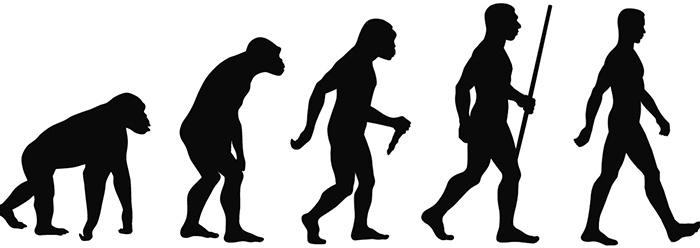Post by 1dave on Mar 24, 2018 15:27:33 GMT -5

en.wikipedia.org/wiki/Human_evolution
The study of human evolution involves many scientific disciplines, including physical anthropology, primatology, archaeology, paleontology, neurobiology, ethology, linguistics, evolutionary psychology, embryology and genetics.[2] Genetic studies show that primates diverged from other mammals about 85 million years ago, in the Late Cretaceous period, and the earliest fossils appear in the Paleocene, around 55 million years ago.[3]
Within the Hominoidea (apes) superfamily, the Hominidae family diverged from the Hylobatidae (gibbon) family some 15–20 million years ago; African great apes (subfamily Homininae) diverged from orangutans (Ponginae) about 14 million years ago; the Hominini tribe (humans, Australopithecines and other extinct biped genera, and chimpanzee) parted from the Gorillini tribe (gorillas) between 9 million years ago and 8 million years ago; and, in turn, the subtribes Hominina (humans and biped ancestors) and Panina (chimps) separated about 7.5 million years ago to 5.6 million years ago.[4]
See:
www.yourgenome.org/stories/evolution-of-modern-humans
The study of human evolution involves many scientific disciplines, including physical anthropology, primatology, archaeology, paleontology, neurobiology, ethology, linguistics, evolutionary psychology, embryology and genetics.[2] Genetic studies show that primates diverged from other mammals about 85 million years ago, in the Late Cretaceous period, and the earliest fossils appear in the Paleocene, around 55 million years ago.[3]
Within the Hominoidea (apes) superfamily, the Hominidae family diverged from the Hylobatidae (gibbon) family some 15–20 million years ago; African great apes (subfamily Homininae) diverged from orangutans (Ponginae) about 14 million years ago; the Hominini tribe (humans, Australopithecines and other extinct biped genera, and chimpanzee) parted from the Gorillini tribe (gorillas) between 9 million years ago and 8 million years ago; and, in turn, the subtribes Hominina (humans and biped ancestors) and Panina (chimps) separated about 7.5 million years ago to 5.6 million years ago.[4]
See:
www.yourgenome.org/stories/evolution-of-modern-humans
The oldest known remains of anatomically modern humans are the Omo I and Omo II skulls. These were found in 1967 in Omo National Park in south-western Ethiopia. The skulls have been dated to 195,000 years ago, highlighting how humans have evolved relatively recently.
So modern science tells us that modern man evolved about 200,000 years ago. What have they been doing?
Weather:


Whoever is right, they had a tough time finding food and shelter.
It is tough to chop down and split trees with just chipped rocks.
What if you found a pile of preshaped rocks to build with?

Even better if they are laying flat like these in Germany instead of standing on end?

Columnar Basalt was uesd long ago to build the "Devils Bridge" near Thueyts France. See the columns in the background?

How could they resist?
are they available?
en.wikipedia.org/wiki/List_of_places_with_columnar_jointed_volcanics










 ... to the New Guys from The ChatBox V.2 Crew
... to the New Guys from The ChatBox V.2 Crew